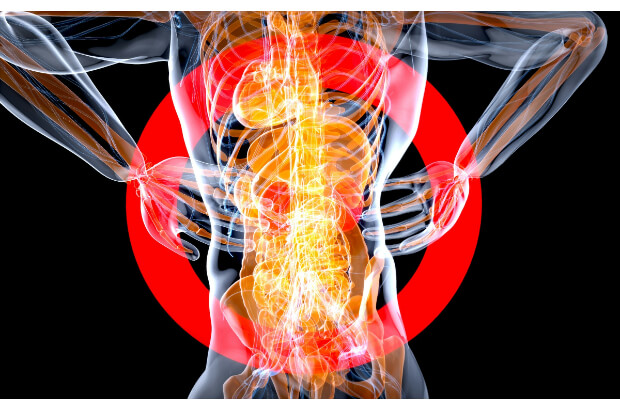
Body + Mind is reader-supported. We may earn an affiliate commission when you buy through some of the links on our site.
Wondering why your stomach feels like a balloon parade after eating pizza or bread? If you’ve been blaming dairy or stress, it might be time to zoom in on a sneaky culprit — gluten intolerance.
This isn’t just about trendy diets or gluten-free Instagram tags. It can wreak havoc on your digestive system, especially if you’re sensitive to it or have celiac disease. And one of the most frustrating side effects? The dreaded gluten belly bloat.
Let’s break down the real symptoms of wheat protein intolerance, how they mess with your gut and mood, and what to do about it, especially if your belly feels like a balloon.
10 Symptoms of Gluten Intolerance
Can Gluten Intolerance Cause Belly Fat?
Gluten intolerance, or non-celiac gluten sensitivity, is when your body doesn’t tolerate gluten, a protein found in barley, wheat and rye grains and flour. It’s different from celiac disease, an autoimmune disorder, and it’s not a wheat allergy involving your immune system.
This condition doesn’t damage your intestines the way celiac does, but it can still cause a whole range of uncomfortable symptoms, especially in your belly. If you’re wondering why gluten intolerance is a thing when your parents and grandparents never had issues with it, the cause is modern farming practices. Commercial farming uses genetically modified grains and wheat for increased crop yields and to produce better flour for bread and pasta dough. These modern strains are higher in glutenous proteins and lower in fiber.

Gluten belly refers to bloating, inflammation and water retention that happens when glutenous proteins trigger an adverse reaction in your body. If you feel like your stomach inflates and hardens after eating bread, pasta or even “healthy” crackers, this protein could be the reason.
This isn’t your average post-meal bloat. It can make your belly feel tight, swollen and gassy for hours or even days. Some people notice their stomach takes on a different gluten belly shape — often round, distended and hard to the touch. Yet, 6% to 7% of Americans suffer from gluten sensitivity, so you’re not alone.
You might also wonder about the difference between gluten belly vs hormonal belly. The bloated stomach tends to appear after meals and comes with digestive symptoms, while a hormonal belly is linked to your cycle, cortisol or menopause. Both can overlap, but timing and triggers usually indicate which it is.
Here are the most common signs your body isn’t loving grain protein, especially if you’re experiencing a classic intolerance belly.
The most obvious sign is belly bloat episodes. After eating gluten, your stomach fills with air, feels painfully distended and your pants get tighter by the minute. This happens because your digestive system struggles to break the grain protein down, triggering fermentation and excess gas.
These bathroom battles are triggered by your intestines facing a revolt with sudden diarrhea or unpredictable constipation. Some people alternate between the two — another sign that gluten’s messing with your gut lining and microbiome balance.

Cramping, aching or just plain ouch sensations can feel like trapped gas, stabbing cramps or a dull ache that sticks around. It’s usually caused by inflammation in the intestines or excess pressure from bloating.
Are you tired all the time? Nutrient malabsorption and deficiency are common with gluten issues and can lead to depletion and fatigue. Even without full-blown celiac disease, your gut may still not absorb iron, B12 or magnesium well. The result? Low energy, foggy mornings and a permanent need for naps.
When your gut messes with your focus, there’s a strong gut-brain connection. After eating gluten, many people report fuzzy thinking, poor concentration and short-term memory problems. Researchers have proven that following a gluten-free diet (GFD) improves mental clarity and reduces brain fog.
Another side effect of gluten-triggered inflammation is sudden headaches and recurring migraines. Grain proteins can lead to neurological symptoms, especially in people who are sensitive. If you frequently get migraines with no obvious cause, gluten intolerance or celiac disease might be worth investigating.
From rashes to itchy bumps, skin reactions like eczema, acne or even dermatitis herpetiformis — a classic celiac rash — can appear after gluten exposure. These are often itchy and persistent, especially around the elbows, knees and scalp. Following a GFD often results in a reduction of these skin ailments.
Do you have pain without injury? Check your plate — gluten protein is 70% gliadins, which triggers a harmful autoimmune response, resulting in chronic gut inflammation. From there, it spreads throughout the body, and you might feel stiff or sore in your knees, wrists or back — often without apparent reason.
Gut issues can mess with your mood, and since this protein can alter your gut bacteria, it affects serotonin production and reabsorption rates. That’s why some people feel unusually irritable, anxious or down after eating gluten. If your stomach and emotions seem linked, this could be why.

Weight gain is not always about calories, and some people gain belly fat due to inflammation and water retention. Others lose weight from poor absorption. If your weight fluctuates and you’ve ruled out other causes, it might be time to look at gluten.
Yes, indirectly. A classic gluten intolerance belly may involve more than just bloating — it can include stubborn visceral fat around your midsection, which is linked to inflammation, insulin resistance and hormonal imbalance.
So while gluten doesn’t cause fat directly, it creates a cascade of effects that make belly fat more likely to stick around.
If these symptoms hit home, try these strategies to reset your gut:

Start with a gluten-free diet and focus on anti-inflammatory foods. Digestive enzymes and probiotics may help, too, especially during the transition.
It’s a term for the bloated, inflamed look and feel that comes from eating gluten when you’re sensitive or intolerant to it. It’s a key sign that your digestive system is not handling it well.
Many people develop symptoms later in adulthood, even if they had no issues with gluten before. Changes in gut health, stress, medications and infections can all trigger new sensitivities.
It depends on your sensitivity. Some people recover in a few hours, while others deal with symptoms for days. The more you expose your body to gluten, the longer recovery may take.
It’s usually a round, bloated abdomen — often hard to the touch — that shows up after eating gluten-containing foods. It can resemble pregnancy bloat and may accompany discomfort or gas.
Your gut doesn’t lie. If you’re dealing with persistent bloating, fatigue or that all-too-familiar gluten belly shape, your body might be waving a very swollen red flag. The good news? You don’t have to live with it.
By identifying your triggers and making some food swaps, you can reclaim your energy, shrink the bloat and finally give your digestive system the break it deserves.
Please share your experiences with gluten intolerance and whether you’ve tried a gluten-free diet on our social channels.
Your email address will only be used to send you our newsletter, and at any time you may unsubscribe. For more information, see our Privacy Policy.